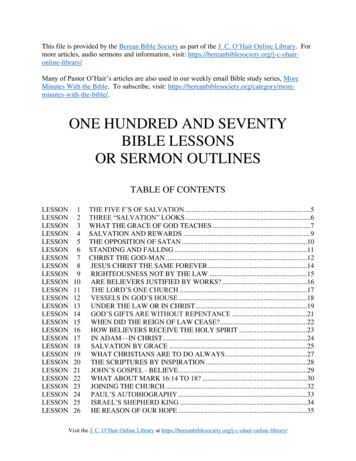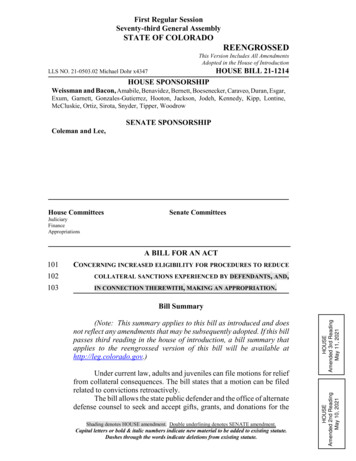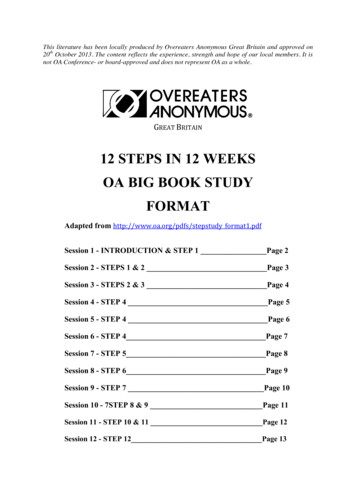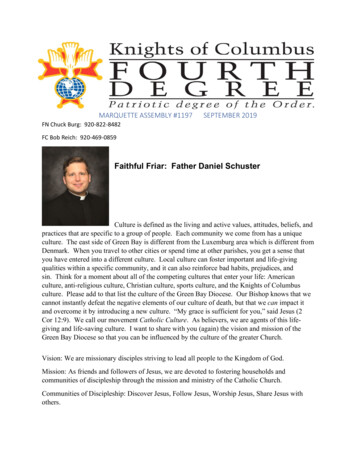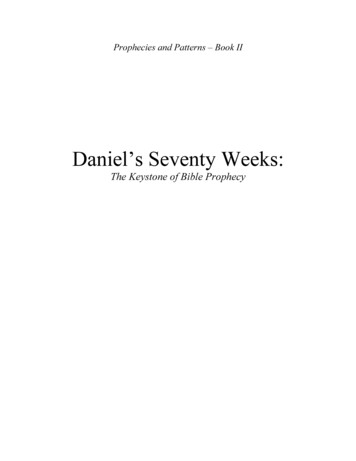
Transcription
Prophecies and Patterns – Book IIDaniel’s Seventy Weeks:The Keystone of Bible Prophecy
Published byPalmoniQuest LLCCopyright 2015 by William StruseAll rights reserved. No part of this book may be reproduced, scanned, or distributed in anyprinted form without permission.ISBN 987-0-9858715-7-4www.the13thenumeration.com
This book is dedicated to all those who love the words of YHWH.
AcknowledgmentsYHWH, thank You for another adventure in Your Word. May these words honorYou.Win, once again I thank you for helping to make this book a reality. It has been ajoy to rediscover this together.Maranatha, Hope, Hannah, Zane, and Noah, you inspire me! Never forget howmuch YHWH loves you.Rachel, once again I am indebted to your editing skill and knowledge of theScripture. You helped make this book better than it would have been. Thank you.
INDEXIntroductionPart I – Keystone of the Covenant1. Bridging the Covenants2. The Forgotten Covenant3. The Holy Mountain4. Redemption in 70 SevensPart II – The Second Temple EraIntroduction1. The Commandment to Restore and Build2. Cyrus the Great: A Decree to Rebuild the Temple and Jerusalem3. Darius ‘the Great’ Artaxerxes: A Decree to Continue Construction on the Temple4. The Seventh Year of Artaxerxes: A Decree for Ezra to Beautify the Temple5. Ezra, the Priest and Scribe: His History and Lineage Relative to the Second Temple Era6. The Twentieth Year of Artaxerxes: A Decree to Rebuild the Walls and Gates of Jerusalem7. Nehemiah the Governor8. Queen of 127 Provinces9. The Fifth Decree: The Word to Return and Build JerusalemPart III – Countdown to the MessiahIntroduction1. Timing the 70 Weeks2. Biblical Time and the Messiah Factors3. The Elusive 13th Month4. Of Circles, Cubits, and Context5. 70 Sevens and the Messiah Factors6. 7 Shabuwa until the Messiah7. The Messiah Cut Off8. The Final Shabuwa9. Daniel 9, the Flood, and YHWH’s Redemptive Purpose10. Strengthening the Covenant11. The Final Shabuwa of Living Witnesses12. The 70th Shabuwa Fulfilled13. The 70th Shabuwa and the Times of the Gentiles14. Daniel 9 and the Messiah’s Purpose
15. Daniel 9: Keystone of the CovenantsINDEX of Charts and Tables(You may view or print a high resolution PDF copy of the charts in this book at the followinglink: Daniel’s 70 Weeks: Charts & Tables)
Important NoticeI believe the information in this book is far too important to limit its message to those who canafford it. The digital version of this book may be copied and shared freely as long as thefollowing conditions are met:1. The book and its contents shall not be modified or changed in any manner whatsoever.2. The book shall not be sold or used for any fundraising or commercial purposes whatsoever.3. A source link to www.the13thenumeration.com must be provided with every copy shared.Various digital versions of this book and my other books in the Prophecy and Patterns areavailable for free to my blog subscribers. It’s free to subscribe and I will never share your emailaddress. The only thing I will share with you is my love for all things Biblical. To become asubscriber to my blog, Where History and the Bible Meet go here: SubscribeIf you are a verified subscriber you may download my books for free here: Subscriber BookDownload. If you are not sure whether you are a subscriber feel free to email me atwstruse@the13thenumeration.com
IntroductionIf someone asked you to explain how the Bible is different from any other religious text inhistory, how would you answer? I believe there are several good ways to answer this question,but to my mind the one that stands out is that the Bible predicted future events that came to pass.It is this use of predictive prophecy that is the divine stamp, if you will, on the Bible’sauthenticity as a genuinely inspired record of events past, present, and yet to come.But the Bible is more than just an organized collection of ancient prophetic texts. TheBible is ultimately a tragic yet redeeming love story. It is the story of a Creator who, in adesperate attempt to save His fallen creations, humbles Himself in order to pay the righteouspenalty for their transgressions; transgressions which, according to His unbreakable word,require the death of those He loves. In order to accomplish this task, the One who made ushumbled Himself and became like us. And when the sentence of death was passed and the timecame to pay the penalty, He stood in our place and received the righteous judgment so that wemight live.There are many prophecies in the Bible that speak of this coming Redeemer who wouldsuffer so that we might live. But in the entire biblical record, there is only one prophecy that tellsus specifically when these events would take place. That prophecy is found in the book ofDaniel, chapter 9. It is known to most of us as the prophecy of 70 weeks, and it is the onlyprophecy in the Bible that gives us a secular date by which we can accurately calculate the firstcoming of the Messiah.But the prophecy of 70 weeks is so much more than a messianic prediction. Thisprophecy, given to a Judean captive named Daniel, is really the bridge between the Old and NewTestaments: a keystone, if you will, that connects old and new. You see, it is the prophecy of 70weeks that spans the five hundred years of silence between the Bible’s two testaments.To give you a clearer picture of why this is so important, the word we understand as“testament” (as in Old and New Testaments) also means “covenant.” In other words, the Old andNew Covenants are the record of mankind’s reconciliation with our Creator. The Old Covenanttexts follow the promised “seed” of the Messiah from Adam, Noah, Abraham, and David up tothe Second Temple era and the prophecy of 70 weeks, which foretells the date of the coming of
the Messiah, Yeshua. This prophecy then spans the next five hundred years and brings us to theNew Covenant when the Messiah at last appeared. The documentation of this covenant, as foundin the collection of books commonly called the New Testament, is made up in part of theeyewitness accounts of the Messiah Yeshua fulfilling the Old Covenant promises concerningmankind’s reconciliation to YHWH. The prophecy of 70 weeks is the central biblical proof textto show that a Hebrew man named Yeshua, born during the reign of the Roman empire, was theexpected Messiah, who strengthened, confirmed, yea, fulfilled the Old Covenant promises of acoming Redeemer.And he shall send Jesus Christ, which before was preached unto you: whom the heavenmust receive until the times of restitution of all things, which God hath spoken by themouth of all his holy prophets since the world began. (Acts 3:20–21)If you’ve read Book I in this series, The 13th Enumeration: Key to the Bible’s MessianicSymbolism, you saw how Yeshua fulfilled the sacrificial symbolism found in the Old Testamentand how it was the apostle Matthew, in his inspired arrangement of Yeshua’s lineage, whoprovided us with the key to understanding this symbolism. How appropriate, then, that we findthis lineage of Yeshua anchoring the first chapter of the first book of the New Testament. It ishere in Matthew 1 that it is recorded that Yeshua is the son of David and of Abraham. It is also inMatthew 1 that we find clues that point us back to Daniel 9 and the prophecy of 70 weeks, thusinexorably linking both covenants together.Let’s take a look once again at Matthew’s amazing lineage of Yeshua:(You may view or print a high reslolution PDF copy of the charts in this book at the followinglink: Daniel’s 70 Weeks: Charts & Tables)
Look closely at the second column with its missing kings. Notice the single missing namebetween the 13th and 14th generations. The missing king is named Jehoiakim. As we saw in BookI of the Prophecy and Patterns series, Jehoiakim means “YHWH raises up.” Indeed, it wasYeshua, the 13th generation of Matthew 1, whom YHWH raised up to become the 14th generationas well, thus completing the list. But let’s look a little deeper. Jehoiakim was left out for another,equally important reason. As we will discover in subsequent chapters, this single missing namebetween the 13th and 14th generations of Yeshua is indeed a key to interpreting the greatestmessianic prophecy in the Scripture.In the third year of the reign of Jehoiakim king of Judah came Nebuchadnezzar king ofBabylon unto Jerusalem, and besieged it . . . And the king spake unto Ashpenaz themaster of his eunuchs, that he should bring certain of the children of Israel, and of theking’s seed, and of the princes . . . Now among these were of the children of Judah,Daniel, Hananiah, Mishael, and Azariah. (Daniel 1:1–6)As we read here, a young man named Daniel, really not much older than a boy, was takencaptive by Nebuchadnezzar along with the Judean king Jehoiakim. It was nearly 70 years laterthat this same Judean captive, now a very old man, received the prophecy of 70 weeks.In the first year of Darius the son of Ahasuerus, of the seed of the Medes, which wasmade king over the realm of the Chaldeans; in the first year of his reign I Danielunderstood by books the number of the years, whereof the word of YHWH came toJeremiah the prophet, that he would accomplish seventy years in the desolations ofJerusalem. (Daniel 9:1–2)Keep in mind that when Daniel read about the 70 years of captivity prophesied byJeremiah, he knew without any doubt that this period of time was drawing to a close, because hisown captivity began those 70 years! It was in this context that Daniel raised his movingintercessory prayer to YHWH for his people and the city of Jerusalem. A short time later, theangel Gabriel came to Daniel and gave him the prophecy of 70 weeks.
In the following pages I’d like to ask you to join me on a thrilling adventure as weexplore this wonderful prophecy given to a Judean captive named Daniel. The importance of thisprophecy cannot be overstated. Again, it is the only prophecy in the entire Bible that provides aspecific, datable timeline for the coming of the Messiah. This prophecy proves that indeedYeshua was the Messiah promised in the Scripture!But this prophecy does not come to us without controversy. What if I told you that mostof what scholars have told us about Daniel 9 and the prophecy of 70 weeks has been built uponerroneous assumptions that have altered our view of the prophecy so much that we have lost ourfocus on the Messiah? Did you know that most commentators on Daniel 9 cannot give a singlebiblical chronological synchronism that clearly defines the starting point for the prophecy of 70weeks during the Persian era? Did you know that the most widely held measure of time used tocalculate Daniel 9 is not even related to a biblical reckoning of time, nor can it be found in thehistorical record? The uncomfortable truth about Daniel 9 is that it is one of the most widelyknown but least understood prophecies in the Bible, and the consequences of misunderstanding itare far-reaching—they shape our understanding not only of Yeshua’s coming but also of the endof the world and our own place in redemptive history.Here is the point. Daniel 9 and the prophecy of 70 weeks influences nearly every aspectof how we see the Yeshua’s life and ministry. The prophecy helps us date Yeshua’s birth, Hisministry, and His death. Daniel 9 is also a large part of the framework upon which we have builtour view of the consummation of this age and Yeshua’s return. That’s an incredible weighthanging on just a few verses out of the thousands in the biblical record. Daniel 9 and theprophecy of 70 weeks is without a doubt the most influential prophecy in the Bible. Because ofthe weight we place on it, it is incumbent upon us to ensure that our understanding is based uponsound biblical fact, not well-intentioned traditions.So once again, as I asked when we began Book I, The 13th Enumeration: Key to theBible’s Messianic Symbolism, let’s roll up our sleeves and dig into the words of the living God.Let’s search for the treasures He has left for us to find. At the end of this journey I can’t promiseyou that you’ll agree with everything I’ve written about the prophecy of 70 weeks, but I willguarantee that once you’ve finished this book, you will have a knowledge of the subject,strengthened by sound and reasonable biblical facts, which will serve you well in building astrong contextual foundation for your own understanding of this incredibly influential prophecy.
One final note: You’ll find that I quote many passages of Scripture in this book, and it ismy hope that you will not gloss over them. They are the real substance of this book. My words inthe following pages are but the rough and uneven stitches holding together some of the beautifulpieces of our Creator’s grand tapestry, in which He reveals His intention to reconcile all mankindthrough Yeshua the promised Messiah. So let’s begin the adventure . . .
Part I:Keystone of the Covenant
Chapter 1:Bridging the Covenants“Seventy weeks are determined upon thy people and upon thy holy city, to finish thetransgression, and to make an end of sins, and to make reconciliation for iniquity, and to bringin everlasting righteousness, and to seal up the vision and prophecy, and to anoint the mostHoly.”Daniel 9:24The book of Genesis tells us of what is arguably the single greatest tragedy in mankind’s history.It records mankind’s first sin and how, as a result, our ancestors were cursed with death and castout of Eden. But thankfully, the story doesn’t end there. Mankind is not left without hope of afuture restoration and reconciliation with our Creator. Before Adam and Eve were cast out of thegarden, our Creator, YHWH, promised them that someday their “seed” would triumph over theserpent who had deceived them. Thus began one of the most ancient and important covenants inthe Bible, the covenant of the promised seed.One way to look at the Bible’s underlying redemptive message is to see the OldTestament (Covenant) texts as YHW
Jeremiah the prophet, that he would accomplish seventy years in the desolations of Jerusalem. (Daniel 9:1–2) Keep in mind that when Daniel read about the 70 years of captivity prophesied by Jeremiah, he knew without any doubt that this period of time was drawing to a close, because his own captivity began those 70 years! It was in this .
